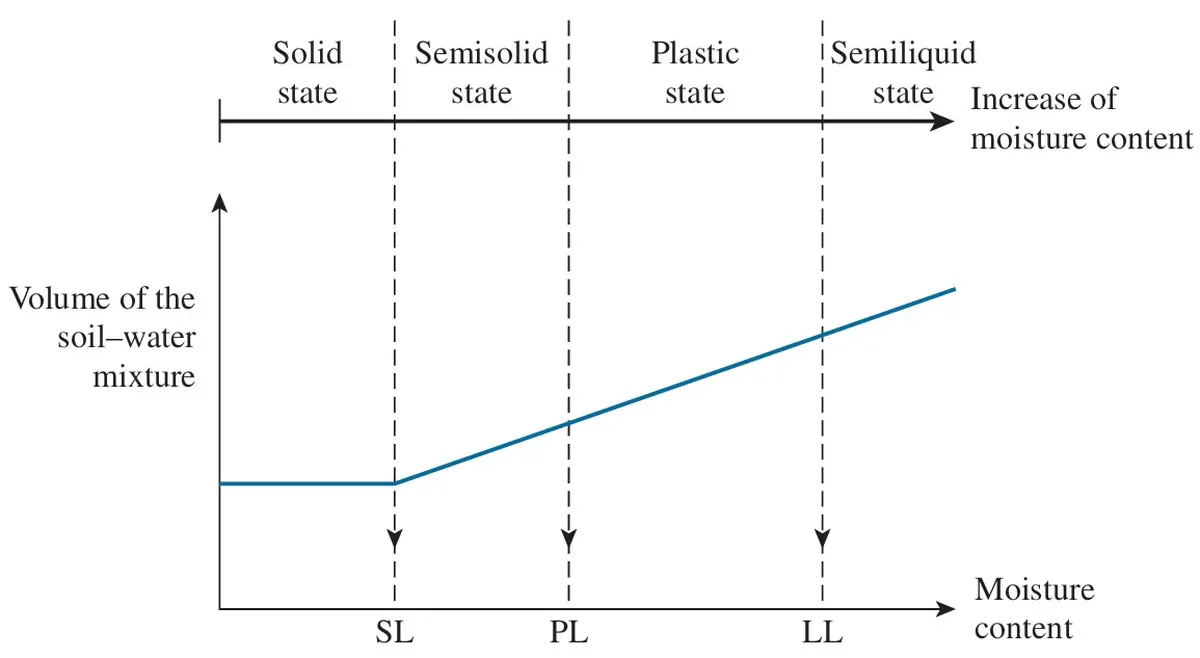Understanding Atterberg Limits: Key Soil Properties

The Atterberg limits are essential indicators used to classify and understand the behavior of clayey soils based on their moisture content. These limits define the transition of soil from one state to another, such as from a liquid-like condition to a solid form. The main states of soil as it dries are the semiliquid, plastic, semisolid, and solid states.
Key Atterberg Limits and Their Definitions
- Liquid Limit (LL): The liquid limit is the moisture content at which soil changes from a semiliquid state to a plastic state. It is determined using Casagrande’s liquid limit device (ASTM Test Designation D-4318). The LL is specifically defined as the moisture content at which the groove closure occurs over a distance of 12.7 mm under 25 blows of the device.
- Plastic Limit (PL): The plastic limit is the moisture content at which the soil begins to crumble when rolled into thin threads of 3.18 mm in diameter. It represents the transition from a plastic to a semisolid state.
- Shrinkage Limit (SL): The shrinkage limit is the moisture content at which the soil no longer decreases in volume as it dries. This marks the boundary between the semisolid and solid states.
The Plasticity Index (PI): Measuring Soil Behavior
The Plasticity Index (PI) is a crucial value derived from the Atterberg limits. It measures the range of moisture content within which the soil behaves plastically.
The formula of the plasticity Index is: PI=LL−PL (eq. 2.30)
A higher PI indicates a more plastic soil, which can have implications for soil strength, stability, and engineering applications.
Graphical Representation of Atterberg Limits

The volume of the soil-water mixture increases with moisture content and transitions between various states as shown below:
- Solid State: Dry soil with minimal water content.
- Semisolid State: Soil begins to show minor plasticity.
- Plastic State: Soil is moldable and cohesive.
- Semiliquid State: Excessive water content causes soil to flow like a liquid.
Why Are Atterberg Limits Important in Civil Engineering?
Understanding the Atterberg limits helps engineers evaluate soil properties for construction and geotechnical projects. These parameters are crucial in determining the soil’s load-bearing capacity, shrink-swell behavior, and overall stability.
Key Applications Include:
- Road construction.
- Foundation analysis.
- Predicting soil settlement and behavior under varying moisture conditions.
By analyzing the liquid limit, plastic limit, and shrinkage limit, engineers can make informed decisions to ensure safety and efficiency in infrastructure projects.
References: Das, B. M., & Sivakugan, N. (2019). Principles of Foundation Engineering (9th ed.). Cengage Learning.
FAQ
What are the Atterberg limits?
The Atterberg limits are a set of three moisture content thresholds used to define the consistency and behavior of fine-grained soils, particularly clay. These limits determine the state of soil as its moisture content changes:
Liquid Limit (LL): The moisture content at which soil transitions from a plastic to a liquid state.
Plastic Limit (PL): The moisture content at which soil starts to crumble when rolled into thin threads of 3.18 mm diameter.
Shrinkage Limit (SL): The moisture content at which the soil no longer reduces in volume as it dries.





Responses